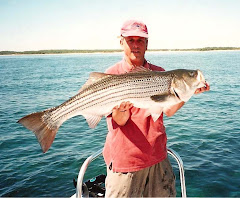
I first met Bruce Marino a number of years back at the Somerset New Jersey Fly Fishing Show. Bruce was one of the show’s featured fly tyers. I was at first struck by both the artfulness and originality of his signature BMAR Wounded Baitfish flies. Equally impressive were throngs of onlookers watching to see how he tied his creations. Since that first meeting I have come to know that the Wounded Baitfish series is a very effective collection of flies for an ever-expanding range of game fish species. These flies have garnered international acclaim and are widely used by fly anglers and guides alike.
Bruce has been at the game of fly fishing and fly tying for over thirty-five years and has traveled to many destinations to fish for both freshwater and saltwater species. Along the path of his travels some of Bruce’s flies have become staples in the arsenals of the local area guides –many consider the Wounded Baitfish as a “go-to” pattern. A number of places have adopted Bruce’s flies including Cooper's Minipi Camps in Labrador where they employ the BMAR Norway Rat, Hex and Stonefly patterns. Guides at Crocodile Bay Lodge in Costa Rica use several of the BMAR Wounded Baitfish patterns as well, where they are used to catch both offshore and inshore species.
Bruce is also an accomplished guide on the crown jewel of Connecticut, the Farmington River, and as a shore guide along the Connecticut coastline. He shares his knowledge and expertise as a writer and in the capacity of fly tying editor for Fly Fishing New England and Fly Fishing the Mid Atlantic States magazines. Bruce is also a March Brown travel fly rods endorsed pro. Among some of the of the projects that he has recently completed is one where he ties flies on circle fly hooks for a study being conducted by Left Kreh along with many working captains in the Northeast. In the past, Bruce was on the research and development team for D.H. Thompson Cobra Vise and he is one of the lead designers for Pacific Fly Group; they have mass-produced many of Bruce’s innovative patterns that are sold worldwide. Bruce will tell you that guiding on the crown jewel of Connecticut, the Farmington River and shore guiding the coastline of Connecticut are now his passions. He is also currently promoting his DVD, "Fly Fishing for Mako Sharks" and completing a second DVD on "Fly Fishing the Farmington River". I was so impressed initially with the BMAR WoundedBaitfish that I included the entire series in my recently fly pattern book, Saltwater Flies of the Northeast. If you would like more information about Bruce’s flies or his guiding operation you can contact him at BMARflies@aol.com
Bruce has been at the game of fly fishing and fly tying for over thirty-five years and has traveled to many destinations to fish for both freshwater and saltwater species. Along the path of his travels some of Bruce’s flies have become staples in the arsenals of the local area guides –many consider the Wounded Baitfish as a “go-to” pattern. A number of places have adopted Bruce’s flies including Cooper's Minipi Camps in Labrador where they employ the BMAR Norway Rat, Hex and Stonefly patterns. Guides at Crocodile Bay Lodge in Costa Rica use several of the BMAR Wounded Baitfish patterns as well, where they are used to catch both offshore and inshore species.
Bruce is also an accomplished guide on the crown jewel of Connecticut, the Farmington River, and as a shore guide along the Connecticut coastline. He shares his knowledge and expertise as a writer and in the capacity of fly tying editor for Fly Fishing New England and Fly Fishing the Mid Atlantic States magazines. Bruce is also a March Brown travel fly rods endorsed pro. Among some of the of the projects that he has recently completed is one where he ties flies on circle fly hooks for a study being conducted by Left Kreh along with many working captains in the Northeast. In the past, Bruce was on the research and development team for D.H. Thompson Cobra Vise and he is one of the lead designers for Pacific Fly Group; they have mass-produced many of Bruce’s innovative patterns that are sold worldwide. Bruce will tell you that guiding on the crown jewel of Connecticut, the Farmington River and shore guiding the coastline of Connecticut are now his passions. He is also currently promoting his DVD, "Fly Fishing for Mako Sharks" and completing a second DVD on "Fly Fishing the Farmington River". I was so impressed initially with the BMAR WoundedBaitfish that I included the entire series in my recently fly pattern book, Saltwater Flies of the Northeast. If you would like more information about Bruce’s flies or his guiding operation you can contact him at BMARflies@aol.com


























